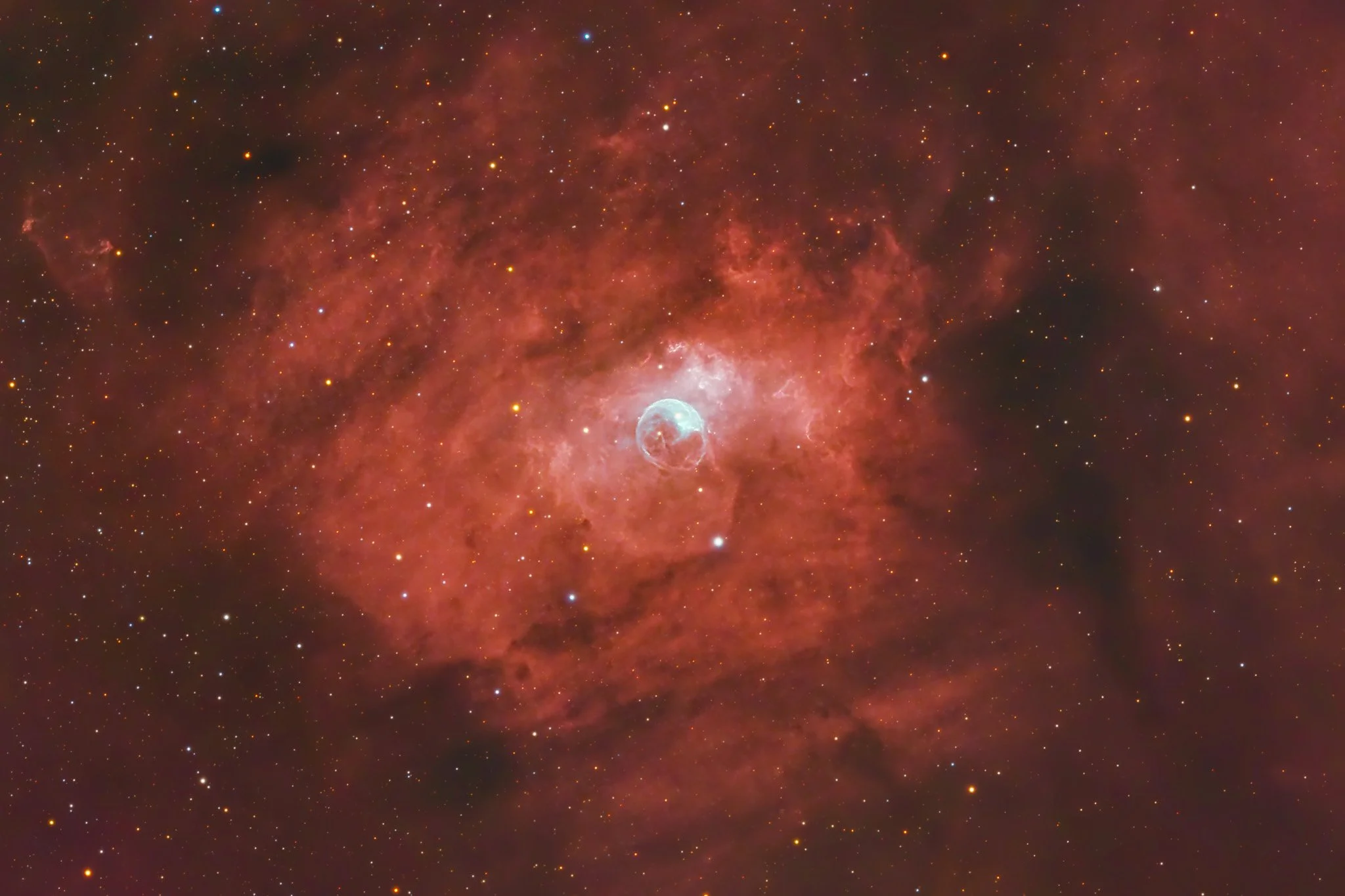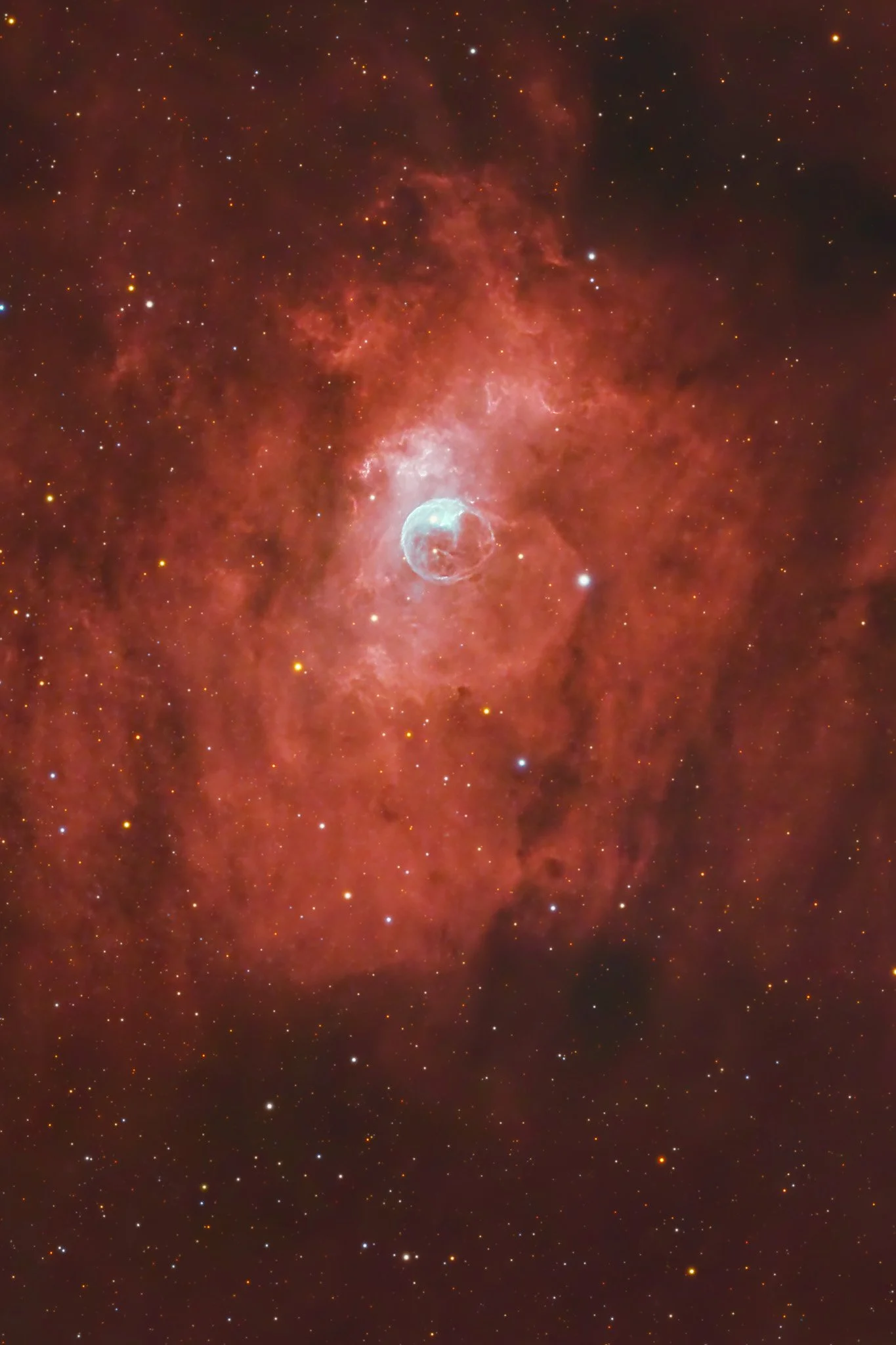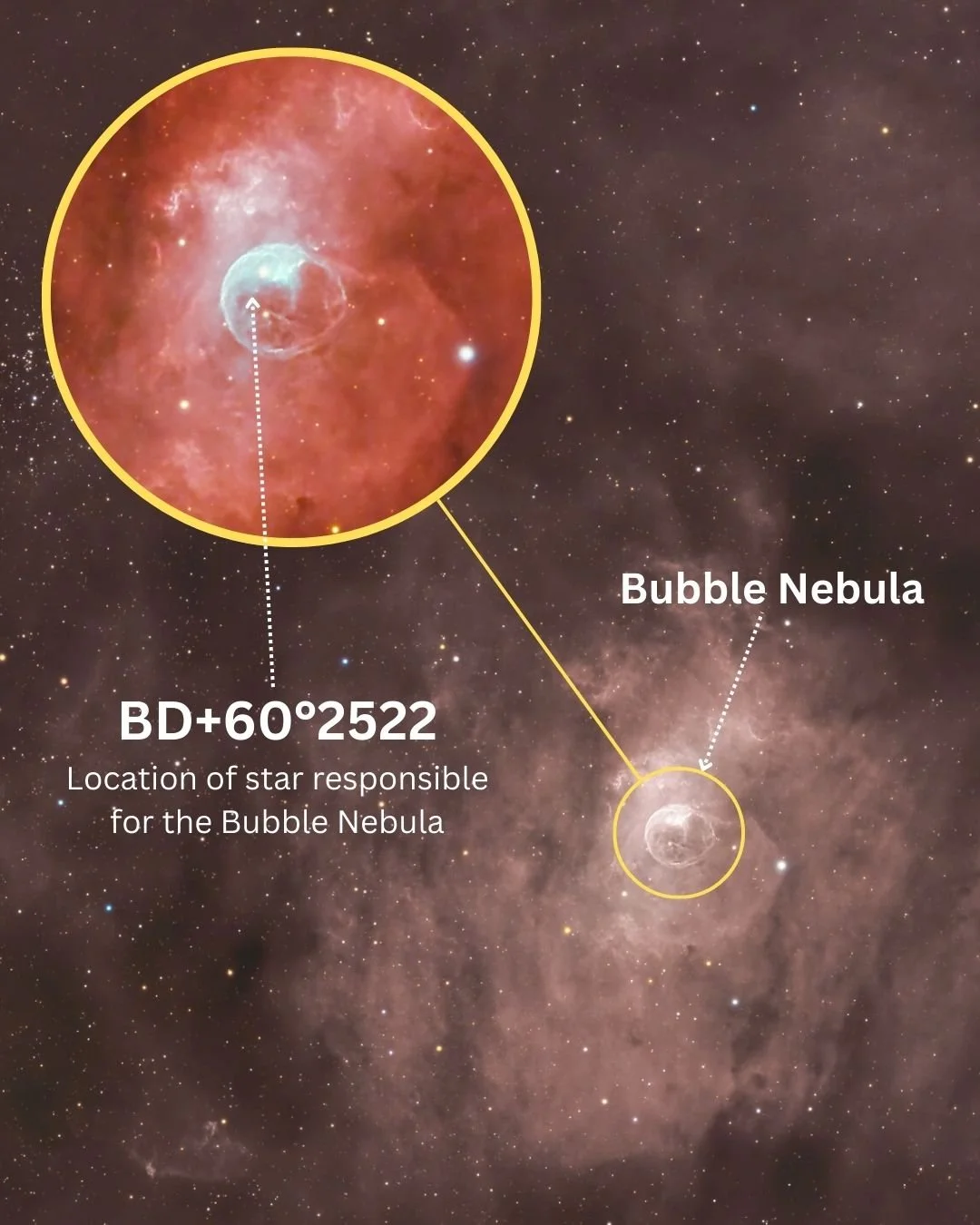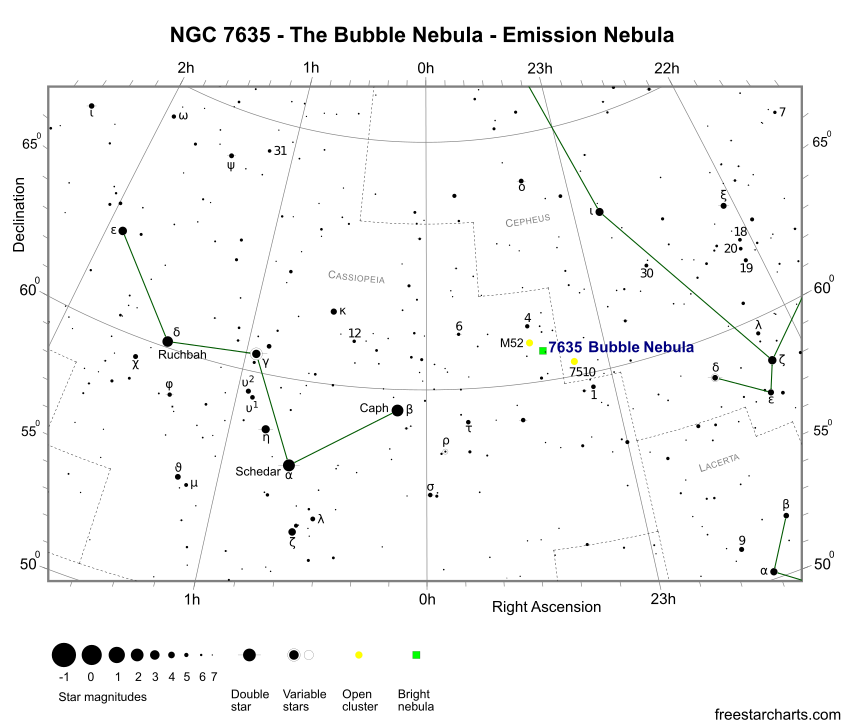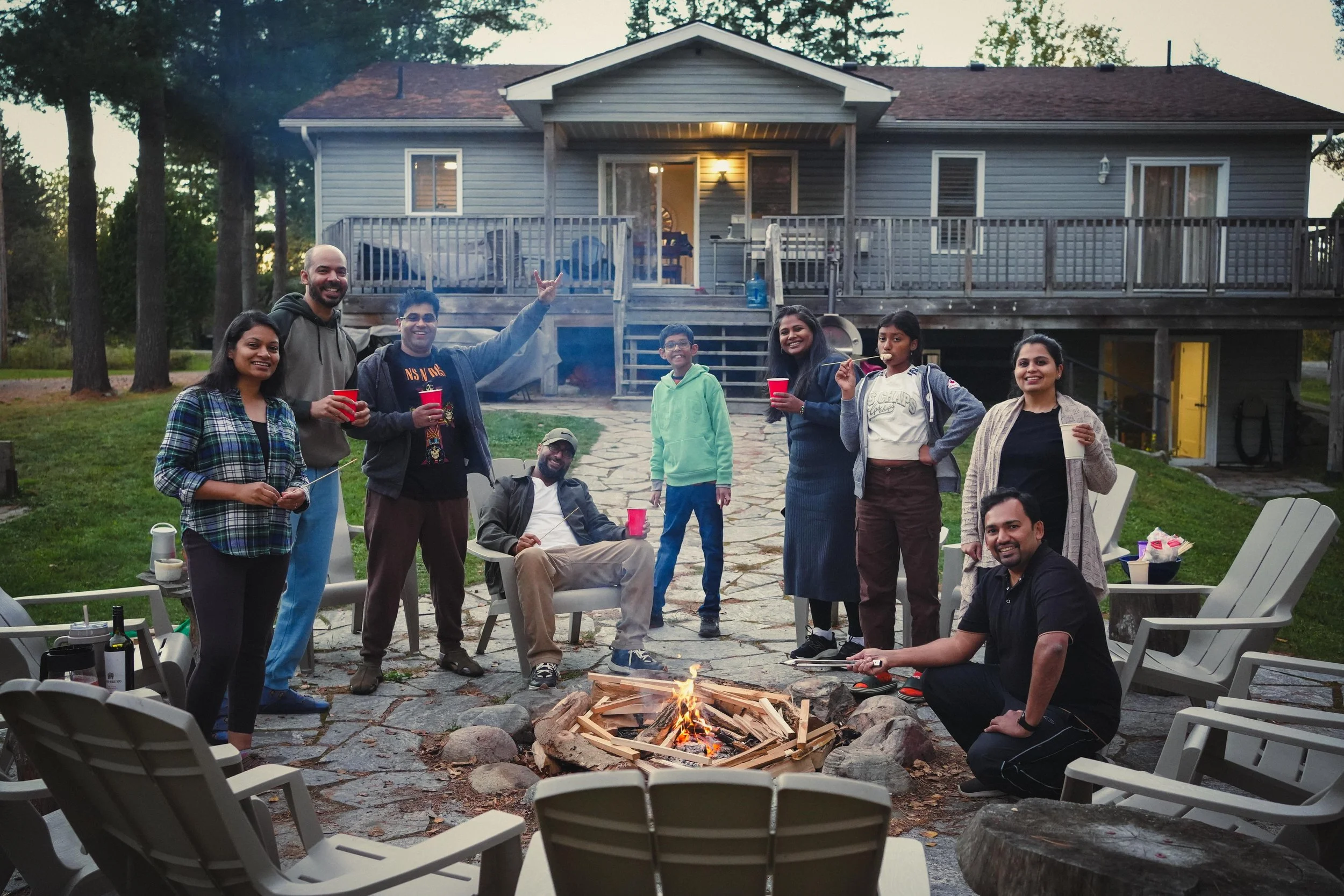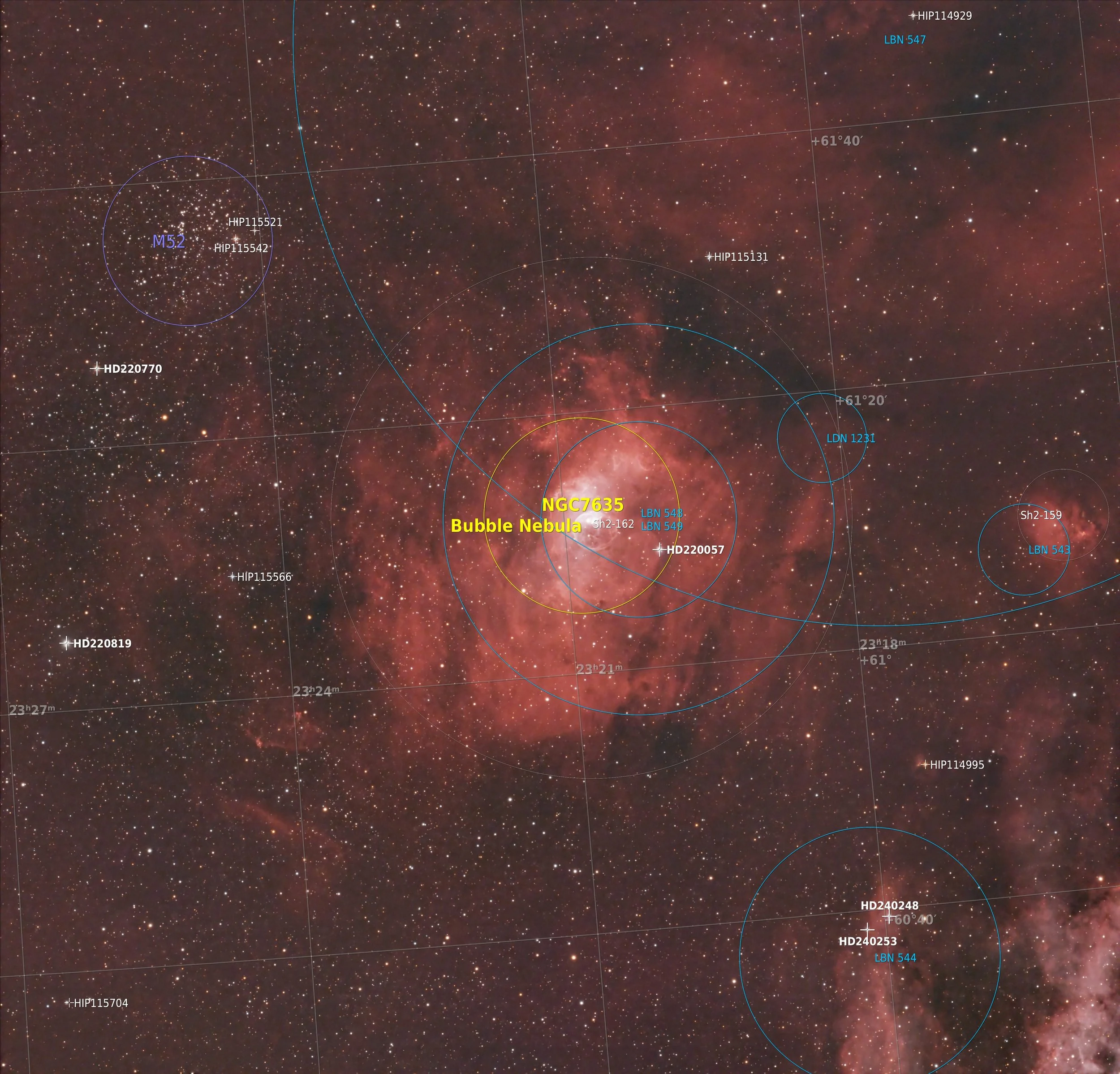The Night Sky - Episode 21
THE BUBBLE NEBULA
This is episode 21 in my series on our night sky
If you’ve ever watched a soap bubble drift lazily through the air, you’ll know how fragile it looks — a shimmering, translucent sphere that could vanish at the slightest touch. Now imagine one that’s seven light-years across, glowing crimson and teal, suspended in the infinite black of space. This is the Bubble Nebula (NGC 7635), a spectacular and curious structure in the constellation Cassiopeia, sculpted by the fierce stellar wind of a massive star at its center.
The Bubble Nebula
A total of 77 exposures of 5 minutes each, for a total of about 6.5 hours of data, were shot to complete this image.
Image by Achint Thomas
It’s been high on my astrophotography wishlist for years. But from my home skies in southern Ontario, capturing the Bubble is tricky. It requires a dark site, a moonless night, and the extended clear weather that’s rare in early fall. This year, all the elements finally aligned — a cottage trip with friends to a Bortle 3 location, a 0% moon phase, and two nights to dedicate to the project.
What is the Bubble Nebula?
The Bubble Nebula was first noted in 1787 by astronomer William Herschel. Located roughly 7,100 light-years away, the nebula’s spherical shell is created by the relentless stellar wind from a hot, massive star. That wind slams into surrounding molecular gas, compressing it into a thin, glowing boundary. The red glow of the nebula comes from hydrogen gas excited by the star’s radiation, while subtle teal tones come from doubly ionized oxygen.
BD+60°2522 - the central star responsible for forming the Bubble Nebula
Image by Achint Thomas
At the heart of this process is the star BD+60°2522, an O-type giant with a luminosity tens of thousands of times that of our Sun. Its mighty stellar wind, travelling at speeds up to 2,500 km/s, is what inflates the nebula into its distinct bubble shape. Without this single, extraordinary star driving the outflow, the Bubble Nebula as we see it today would not exist.
If you were to scale the Bubble down to Earth’s size, the central star would be only the size of a golf ball — an incredible image of power shaping beauty.
Star chart showing how to locate the Bubble nebula. It is close to the constellation of Cassiopeia.
Image by Achint Thomas
For backyard observers hoping to spot it, the Bubble Nebula lies in the rich star fields of Cassiopeia. Start by tracing the familiar “W” shape of the constellation high in the northern sky. The nebula is located near the bright open cluster M52 at the western end of the W, making the cluster a useful signpost. While the Bubble itself is too faint for the naked eye, larger amateur telescopes under dark skies — or long-exposure imaging setups — can reveal its delicate form.
Capturing the Bubble
I began the first night setting up in the expansive backyard of our cottage getaway, the autumn air crisp and still. The familiar hum of the mount came alive as the SkyWatcher Star Adventurer GTi slewed toward Cassiopeia. My imaging train was built for efficiency: a ZWO ASI 533MC Pro cooled to -10°C for clean, low-noise data, paired with a Sigma 100–400mm lens set to 400mm at f/6.3. In front sat an Optolong L-Ultimate dual narrowband filter, designed to isolate the Hα and OIII wavelengths that make the Bubble’s shell and surrounding gas stand out. Guiding was handled by a ZWO 120mm Mini and a matching mini guide scope, all controlled via the ZWO ASIAir Pro. A SvBony dew heater kept moisture at bay, powered by an AIMTOM 194Wh portable station that ran the entire setup through the night.
My current custom-built OTA for astrophotography. I built this component by component over the course of two years for my specific needs.
Image by Achint Thomas
Light transmission curve of the Optolong L-Ultimate filter, a typical dual-narrowband filter. It is designed to allow the transmission of Hα (656.3 nm), Hβ (486.1 nm) and OIII (500.7 nm and 495.9 nm) wavelengths while suppressing all other wavelengths. The tight bandpass of 3nm ensures maximal rejection of light pollution.
Over the two nights, I captured 77 sub-exposures, each 300 seconds long, for a total of about 6.5 hours of integration time. Calibration frames — 30 darks, 30 flats, and 30 dark flats — ensured that the final stack would be as clean and accurate as possible. The first night ended abruptly when clouds swept in around 2 a.m., but the second night was flawless.
Sharing the Sky With Friends
One of the unexpected joys of this project was the company I shared that night under the stars. Usually, I go alone to remote locations for astrophotography, but this time I had friends with me. One by one, they stepped out of the cottage and came over to check out the imaging setup, curious about the different parts of the rig. I explained why each component mattered from a practical point of view: the star tracker is essential because without it, stars would trail across the frame in just a few seconds — the tracker counteracts Earth’s rotation and makes it possible to take long exposures that reveal faint nebulae. The cooled astro-camera dramatically reduces thermal noise that builds up in uncooled sensors, giving a much cleaner image when stacking dozens of exposures, while also being more sensitive to the faint light of emission nebulae. The guide scope adds another layer of precision by locking onto a guide star and feeding tiny corrections to the mount, ensuring the target stays perfectly centred for hours at a time.
We didn’t stop there. I pointed out some key signposts of the northern hemisphere night sky — the Big Dipper, Polaris, Cygnus, and the Summer Triangle — explaining how the patterns slowly rotate around Polaris over the course of the night. Finally, I traced Cassiopeia’s familiar W-shape and showed them how it can be used to locate the Bubble Nebula itself.
Their fascination grew as I showed them how the Bubble was slowly emerging on the live stacking feed in the ASIAir app — at first just a ghostly smudge, then a distinct, glowing sphere. We ended up spending hours under the stars, watching satellites glide past and talking about the sheer scale of the universe.
Good company, laughter, food on the grill, and music by the fire — the perfect backdrop before a night of stargazing. Sharing the Bubble Nebula under dark skies was more than just an astrophotography session; it was a celebration of friendship, some much-needed relaxation, and marvelling at the wonder of the universe.
Processing the Image
Back home, the real work began. I brought the data into PixInsight, where the challenge was to bring out the delicate structure of the Bubble without overwhelming it with the surrounding nebula’s glow.
The first hurdle was balancing the Hα and OIII channels. The Bubble’s outer rim shines strongly in hydrogen red, but its inner structures and faint outer shell are laced with teal oxygen emissions. Too much emphasis on one would erase the subtle interplay between them.
Star management was another critical step. The Cassiopeia region is dense with stars, and without careful control they can dominate the frame. Using star-reduction techniques, I kept them present but restrained, allowing the nebula to be the focal point.
The final push was revealing the faint background nebulosity without introducing noise. Careful application of noise reduction and local contrast enhancement allowed the dark, wispy clouds surrounding the Bubble to emerge, giving the image depth and context. My artistic choice was to keep the Bubble’s rim soft rather than razor-sharp — a deliberate nod to its delicate, floating appearance.
Other Notable Objects Nearby
The Bubble Nebula doesn’t float alone in this patch of sky. Just to its northwest sits Messier 52 (M52), a rich open star cluster that shines brightly in widefield views of the region. M52 contains several hundred stars, some of them only a few hundred million years old — cosmic youngsters compared to the Bubble’s central powerhouse star. The contrast between the delicate sphere of gas and the sparkling jewel-box of M52 makes this part of Cassiopeia particularly rewarding for observers and imagers alike.
Annotated image of the region around the Bubble Nebula.
Image by Achint Thomas
Also nearby is a faint expanse of emission nebulosity often referred to as the Northern Lagoon Nebula (Sh2-157a), along with the sprawling complex of interstellar dust and gas that forms part of Cassiopeia’s rich tapestry. Together, these objects create a neighbourhood brimming with variety — clusters, nebulae, and dark dust lanes all sharing the same field of view.
The Bubble Nebula is a paradox. It looks delicate, even fragile, yet it’s born from forces so intense they reshape entire regions of space. In a few million years, the massive star at its center will go supernova, scattering the shell into the interstellar medium. For now, though, it drifts quietly in Cassiopeia — a cosmic soap bubble inflated by the breath of a giant.
Next time you’re under a dark sky, trace out the “W” of Cassiopeia and know that somewhere in that familiar pattern lies a sphere of gas big enough to swallow star systems whole, yet beautiful enough to rival the prettiest sunset on Earth.
Check out some other nebulae I have captured.
Capture details
Camera: ZWO ASI 533MC Pro
Gain: 100
Sensor Temperature: -10°C
Lens: Sigma 100-400mm f/5-6.3 DG OS HSM
Focal length: 400mm (equivalent to 640mm full-frame)
f-Ratio: 6.3
Sub-exposure length: 300 seconds
Number of exposures: 77 (Optolong L-Ultimate filter)
Total integration time: ~6.5 hours
Calibration frames: 30 darks, 30 flats, 30 dark flats
Mount: SkyWatcher Star Adventurer GTi
Guide camera: ZWO 120mm mini
Guide scope: ZWO Mini Guide scope
Capture control: ZWO ASIAir Pro
Dew control: SvBony dew heater
Field Power: AIMTOM 194Wh Portable Power Station
Sky quality: Bortle 3
Moon phase: New moon
Processing: PixInsight
